Evaluation of the Impact Caused by the Snowfall after Storm Filomena on the Arboreal Masses of Madrid
Abstract
:1. Introduction
2. Material and Methods
2.1. Study Area
2.2. The Tree Mass of Madrid
2.3. Methodology and Data Pre-Processing Sources Used
- ▪
- Daily images from the MODIS (Moderate-Resolution Imaging Spectroradiometer) satellite, Terra sensor, with 36 spectral channels, between the visible, near, medium and thermal infrared, with a spatial resolution of 250, 500 and 1000 m, respectively, have been used for the general analysis of the extent of snow cover in the Iberian Peninsula and in particular in Madrid. Here, we have selected the combinations in natural colour (1-4-3, R-V-A) to monitor cloudiness, and in false colour 3-6-7 (R-V-A), to discriminate and measure snow cover. These spectral bands correspond to the blue channel (3: 459–479 µm) and mid-infrared (6: 1628–1652 µm and 7: 2105–2155 µm), with a spatial resolution of 500 m, which when combined with band 1 (visible, at 620–670 µm) an image with a final resolution of 250 m is obtained, offering images with greater detail. The source for consulting and downloading images has been the NASA Worldview server [39,40,41].
- ▪
- A Landsat 8 image, with a spatial resolution of 30 m in the visible and near infrared and a thermal channel at 100 m, selected a few days after the passage of the storm (1 November 2021) from the US Earthexplorer server [40,42]. With this, the snow cover in the Community of Madrid was analysed visually and spectrally and the surface temperature of the Community of Madrid and neighbouring areas was calculated, from band 10, thermal infrared with 10.30–11.30 μm, according to the methodologies of Valor and Caselles [43] and Jiménez-Muñoz et al. [44].
- ▪
- Images from the European Sentinel 2 satellite, with 10 and 20 m spatial resolution in the visible and infrared bands, selected before and after the passage of the storm from the Copernicus download server, processing level 2 [45].
- ✓
- Natural false colour band combination (B8-B4-B3, R-V-A).
- ✓
- Supervised classification of the Sentinel 2 image of 6 January 2021, according to the parametric rule of minimum distance.
- ✓
- Normalized Difference Vegetation Index (NDVI): based on mathematical algorithm between parts of the electromagnetic spectrum where vegetation has high reflectance (near infrared) and where vegetation has low reflectance (red) [50] (IRc-red)/(IRc+red).
- ✓
- Images of changes between the NDVI values of February 2020 and those of 2021. These dates have been chosen to collect the differences in the reflectivity of the plant biomass of two upcoming winters, before and after the passage of Storm Filomena.
| Images | Date | Areas Analysed and Affected by Snow | Bands Used | Spatial Resolution (m) |
|---|---|---|---|---|
| MODIS/Terra | Daily of 6 January 2021 to 24 January 2021 | Spanish peninsular centre | 1-4-3 3-6-7 | 250 (Visible) 500 (NIR) 1000 (TIR) |
| Landsat/8 | 12 January 2021 | Comunidad de Madrid (Scene 201/032) | 1 a 7, 10 and 11 | 30 (Vis, NIR and SWIR) 100 m (TIR) |
| Sentinel/2 | 6 January 2021 11 January 2021 18 January 2021 23 February 2020 27 February 2021 | Municipality of Madrid (Scene 30TVK) | 1 a 4 8, 11 and 12 | 10 m (Visible and NIR) 20 m (SWIR) |
| Photos PNOA | 2016 | Leaves 533, 534, 559 y 582 | Natural Color | 50 cm |
3. Results and Discussion
3.1. Storm Filomena, Features and Extension
3.2. Estimation of Damage to the Tree Mass Using Satellite Images
- Repopulation pine forests of Monte de El Pardo and Casa de Campo, with high density (1 and 2, Figure 9).
- Holm oak and pine forests to the north of the municipality (Finca de tres Cantos—Monte de Viñuelas), in the shady exposures, since they are the ones that harboured icy temperatures for the longest time (3, Figure 9).
4. Conclusions
- -
- The height of snow reached in the city of Madrid (52.9 mm) is unprecedented in the last century, so it is considered rare and extraordinary, although it has happened in the month with the greatest risk of snowfall (January).
- -
- The permanence of the snow cover in Madrid for about ten days responds both to the amount fallen and to the subsequent atmospheric stability. Consequently, an intense thermal inversion took place, which left a large part of the municipality of Madrid with frigid surface temperatures (from −13 °C to −2.5 °C), and less rigorous ones in the Sierra (from −2.5 °C to 4 °C).
- -
- The most affected trees have been the conifers because, by keeping their leaves, they retain more snow. Among them, the most affected have been the pine forests, also the most abundant ones (Pinus pinea and Pinus halepensis), with a notable loss of stems and branches, and cypresses (Cuppresus sp.), more due to the bending of their branches than to the fall of individual trees. To a lesser extent, some firs and cedars have also been affected, since their pyramidal appearance and more open branches make them better adapted to the weight of the snow. In some parks, private gardens and nurseries, the losses due to freezing of some non-native and exotic species in Madrid (Arecaceae, Agavaceae or Cactaceae families) are not negligible, but quantitatively they are very minor. In Monte de El Pardo and Casa de Campo, the loss is also considerable for the holm oaks (Quercus ilex).
- -
- In general, in all the parks with a predominance of conifers, regardless of their location, the damage has been very intense wherever the support of the trees was more compromised because they are on slopes, or next to paths and paths with highly degraded soils (mainly regosols).
- -
- Although it is difficult to calculate the forest mass damaged by the accumulation of snow, a first estimate in the municipality of Madrid shows a loss of around 11% of the plant cover in winter, rising to 14% in the districts with the two large lungs of the city: El Monte de El Pardo and Casa de Campo. In both, the damage is maximum in the pine forest repopulation sectors, with high density.
- -
- The combined use of satellite images of different spatial resolutions (MODIS/TERRA, Landsat 8 and Sentinel 2) has made it possible to better understand the extent of this extraordinary snowfall and to estimate some of the impacts on evergreen trees. However, to assess the real losses, satellite images, photogrammetric flights or current and more detailed lidar images are required, which will be convenient to carry out when the tasks of felling and removing the damaged tree material are completed.
- -
- As an essential methodological problem, it should be mentioned that there is enormous difficulty in knowing and accurately mapping the number of trees prior to the storm in Madrid, as the different available sources disagree with each other, since in Madrid numerous juxtaposed ownerships converge and there is a consequent variety of management, production and distribution of information, which makes it especially complex to collect all the information on all green spaces.
Author Contributions
Funding
Institutional Review Board Statement
Informed Consent Statement
Data Availability Statement
Acknowledgments
Conflicts of Interest
References
- Tapiador, F.J.; Villalba-Pradas, A.; Navarro, A.; Martín, R.; Merino, A.; García-Ortega, E.; Sánchez, J.L.; Kim, K.; Lee, G.A. Satellite View of an Intense Snowfall in Madrid (Spain): The Storm ‘Filomena’ in January 2021. Remote Sens. 2021, 13, 2702. [Google Scholar] [CrossRef]
- Handmer, J.; Honda, Y.; Kundzewicz, Z.W.; Arnell, N.; Benito, G.; Hatfield, J.; Mohamed, I.F.; Peduzzi, P.; Wu, S.; Sherstyukov, B.G.; et al. Changes in impacts of climate extremes: Human systems and ecosystems. In Managing the Risks of Extreme Events and Disasters to Advance Climate Change Adaptation; Field, C.B., Barros, V., Stocker, T.F., Qin, D.J., Dokken, K.L., Ebi, M.D., Mastrandrea, K.J., Mach, G.-K., Plattner, S.K., Allen, M., et al., Eds.; Cambridge University Press: Cambridge, UK, 2012; pp. 231–290. [Google Scholar]
- Kunkel, K.E.; Karl, T.R.; Brooks, H.; Kossin, J.; Lawrimore, J.H.; Arndt, D.; Bosart, L.; Changnon, D.; Cutter, S.L.; Doesken, N.; et al. Monitoring and understanding trends in extreme storms: State of knowledge. Bull. Am. Meteorol. Soc. 2013, 94, 499–514. [Google Scholar] [CrossRef]
- Harding, R.J.; Pomeroy, J.W. The energy balance of the winter boreal landscape. J. Clim. 1996, 9, 2778–2787. [Google Scholar] [CrossRef]
- Link, T.E.; Marks, D. Point simulation of seasonal snowcover dynamics beneath boreal forest canopies. J. Geophys. Res. 1999, 104, 27841–27857. [Google Scholar] [CrossRef]
- Link, T.E.; Marks, D. Distributed simulation of snowcover massand energy-balance in the boreal forest. Hydrol. Processes 1999, 13, 2439–2452. [Google Scholar] [CrossRef]
- García Alvarado, J.M.; Pérez González, M.E.; García Rodríguez, M.P. Sellado de suelos, fragmentación y conectividad ecológica en la conurbación de Madrid (España). Boletín Asoc. Española Geogr. 2020, 85, 4. [Google Scholar] [CrossRef]
- Gómez Mendoza, J. Cultura ambiental tradicional y arbolados de Madrid. An. Geogr. Univ. Complut. 1995, 15, 361–373. [Google Scholar]
- Gómez Mendoza, J. El Gobierno de la Naturaleza en la Ciudad. Ornato y Ambientalismo en el Madrid Decimonónico; Real Academia de la Historia: Madrid, Spain, 2003; 154p. [Google Scholar]
- Coates, U.A. Urban congestion and green belts. J. R. Soc. Promot. Health 1955, 76, 542–548. [Google Scholar] [CrossRef]
- Blancher, G. Urban green spaces. Rev. D’hygiène Médecine Soc. 1963, 11, 219–237. [Google Scholar]
- Laurie, I.C. Nature in cities: The natural environment in the design and development of urban green space. In Nature in Cities; Wiley: Hoboken, NJ, USA, 1979; 428p. [Google Scholar]
- Wild, C. Managing the landscape of towns. In Trees in Towns: Maintenance and Management; Nichols Pub. Co.: London, UK, 1981; pp. 128–164. [Google Scholar]
- Kweon, B.S.; Sullivan, W.C.; Wiley, A.R. Green common spaces and the social integration of inner-city older adults. Environ. Behav. 1998, 30, 832–858. [Google Scholar] [CrossRef]
- Bernatzky, A. The contribution of tress and green spaces to a town climate. Energy Build. 1982, 5, 1–10. [Google Scholar] [CrossRef]
- Almendros-Coca, M.A. Climate features of Retiro park, Madrid. Aspectos climáticos del parque del Retiro (Madrid). Estud. Geográficos 1992, 53, 217–239. [Google Scholar] [CrossRef]
- Bowler, D.E.; Buyung-Ali, L.; Knight, T.M.; Pullin, A.S. Urban greening to cool towns and cities: A systematic review of the empirical evidence. Landsc. Urban Plan. 2010, 97, 147–155. [Google Scholar] [CrossRef]
- Susca, T.; Gaffin, S.R.; Dell’Osso, G.R. Positive effects of vegetation: Urban heat island and green roofs. Environ. Pollut. 2011, 159, 2119–2126. [Google Scholar] [CrossRef]
- Ng, E.; Chen, L.; Wang, Y.; Yuan, C. A study on the cooling effects of greening in a high-density city: An experience from Hong Kong. Build. Environ. 2012, 47, 256–271. [Google Scholar] [CrossRef]
- Gago, E.J.; Roldan, J.; Pacheco-Torres, R.; Ordóñez, J. The city and urban heat islands: A review of strategies to mitigate adverse effects. Renew. Sustain. Energy Rev. 2013, 25, 749–758. [Google Scholar] [CrossRef]
- Maimaitiyiming, M.; Ghulam, A.; Tiyip, T.; Pla, F.; Latorre-Carmona, P.; Halik, T.; Caetano, M. Effects of green space spatial pattern on land surface temperature: Implications for sustainable urban planning and climate change adaptation. ISPRS J. Photogramm. Remote Sens. 2014, 89, 59–66. [Google Scholar] [CrossRef] [Green Version]
- Aram, F.; Solgi, E.; García, E.H.; Mosavi, A.; Várkonyi-Kóczy, A.R. The cooling effect of large-scale urban parks on surrounding area thermal comfort. Energies 2019, 12, 3904. [Google Scholar] [CrossRef] [Green Version]
- Gál, T.; Mahó, S.I.; Skarbit, N.; Unger, J. Numerical modelling for analysis of the effect of different urban green spaces on urban heat load patterns in the present and in the future. Comput. Environ. Urban Syst. 2021, 87, 101600. Available online: https://ma.x-mol.com/paperRedirect/1354164608240115712 (accessed on 15 January 2022). [CrossRef]
- Tzoulas, K.; Korpela, K.; Venn, S.; Yli-Pelkonen, V.; Kaźmierczak, A.; Niemela, J.; James, P. Promoting ecosystem and human health in urban areas using green infrastructure: A literature review. Landsc. Urban Plan. 2007, 81, 167–178. [Google Scholar] [CrossRef] [Green Version]
- Du, H.; Zhou, F.; Cai, Y.; Li, C.; Xu, Y. Research on public health and well-being associated to the vegetation configuration of urban green space, a case study of Shanghai, china. Urban For. Urban Green. 2021, 59, 126990. [Google Scholar] [CrossRef]
- Alonso, R.; Vivanco, M.G.; González-Fernández, I.; Bermejo, V.; Palomino, I.; Garrido, J.L.; Artíñano, B. Modelling the influence of peri-urban trees in the air quality of Madrid region (Spain). Environ. Pollut. 2011, 159, 2138–2147. [Google Scholar] [CrossRef] [PubMed]
- Livesley, S.J.; McPherson, E.G.; Calfapiedra, C. The Urban Forest and Ecosystem Services: Impacts on Urban Water, Heat, and Pollution Cycles at the Tree, Street, and City Scale. J. Environ. Qual. 2015, 45, 119–124. [Google Scholar] [CrossRef] [PubMed]
- Nowak, D.J.; Crane, D.E.; Stevens, J.C. Air pollution removal by urban trees and shrubs in the United States. Urban For. Urban Green. 2006, 4, 115–123. [Google Scholar] [CrossRef]
- Nowak, D.J.; Hirabayashi, S.; Bodine, A.; Hoehn, R. Modeled PM2.5 removal by trees in ten U.S. cities and associated health effects. Environ. Pollut. 2013, 178, 395–402. [Google Scholar] [CrossRef] [PubMed]
- de Madrid, C.; Madrid es la Cuarta Ciudad Más Arbolada del Mundo. Censo de Zonas Verdes. 2018. Available online: https://www.espormadrid.es/2018/05/madrid-es-la-cuarta-ciudad-mas-arbolada.html (accessed on 10 December 2021).
- AEMET. Agencia Estatal de Meteorología. Storm Filomena 2021. Available online: https://www.aemet.es/es/conocermas/borrascas/2020--2021/estudios_e_impactos/filomena (accessed on 15 January 2021). (In Spanish).
- Llasat, M.C.; Turco, M.; Quintana-Segui, P.; Llasat-Botija, M. The snow storm of 8 March 2010 in Catalonia (Spain): A paradigmatic wet-snow event with a high societal impact. Nat. Hazards Earth Syst. Sci. 2014, 14, 427–441. Available online: https://nhess.copernicus.org/articles/14/427/2014/} (accessed on 10 January 2022). [CrossRef]
- IGME. Mapa Geológico de España, Escala 1:200.000; Departamento de Publicaciones del Instituto Geológico y Minero de España: Madrid, Spain, 1971. [Google Scholar]
- Fernández García, F.; Coca, M.Á.A.; Gómez, A.L. La Influencia del Relieve en la Isla de Calor de Madrid: Las Vaguadas del Manzanares. Estudios Geográficos 1996, 57, 473–494. [Google Scholar] [CrossRef] [Green Version]
- IUSS Working Group WRB. World Reference Base for Soil Resources 2014, update 2015. In ternational soil classification system for naming soils and creating legends for soil maps. In World Soil Resources Reports No. 106; FAO: Rome, Italy, 2015; Available online: http://www.fao.org/3/i3794en/I3794en.pdf (accessed on 18 November 2021).
- Morcillo San Juan, A.; Borrajo Millán, J.M.; Rastrollo Gonzalo, A.; Nowak, D.J. Valor del Bosque Urbano de Madrid; Ayuntamiento de Madrid: Madrid, Spain, 2019; p. 83. Available online: https://www.madrid.es/UnidadesDescentralizadas/ZonasVerdes/TodoSobre/ValorBosqueUrbanoMadrid/Valor%20Bosque%20Urbano%20de%20Madrid.pdf (accessed on 12 October 2021).
- Comunidad de Madrid. Ecosistemas Forestales. 2020. Available online: https://www.comunidad.madrid/servicios/urbanismo-medio-ambiente/ecosistemas-forestales (accessed on 18 September 2021).
- González Granados, J. Flora y vegetación gipsícola, halófila y nitrófila de Madrid. Foresta 2011, 52, 46–57. [Google Scholar]
- Wetterzentrale, Mapas de Superficie y 500 hPa. 2021. Available online: https://www.wetterzentrale.de/ (accessed on 10 October 2021).
- Sánchez Rodríguez, J. Situaciones atmosféricas en España; (Atmospheric situations in Spain); MOPT: Madrid, Spain, 1993. [Google Scholar]
- NASA MODIS Images. 2021. Available online: https://worldview.earthdata.nasa.gov/ (accessed on 15 October 2021).
- USGS Landsat 8 Image, Level 2. 2021. Available online: https://earthexplorer.usgs.gov (accessed on 3 October 2021).
- Valor, E.; Caselles, V. Mapping land surface emissivity from NDVI: Application to European, African, and South American areas. Remote Sens. Env. 1996, 57, 167–184. [Google Scholar] [CrossRef]
- Jiménez-Muñoz, J.C.; Sobrino, J.A.; Skokovic, D.; Mattar, C.; Cristobal, J. Land surface temperature retrieval methods from landsat-8 thermal infrared sensor data. IEEE Geosci. Remote Sens. Lett. 2014, 11, 1840–1843. [Google Scholar] [CrossRef]
- ESA. Copernicus. (European Space Agency). Available online: http://www.esa.int/Our_Activities/Observing_the_Earth/Copernicus/Sentinel-2 (accessed on 27 October 2021).
- García, P.; Pérez, M.E.; Guerra, A. Using TM images to detect soil sealing change in Madrid (Spain). Geoderma 2014, 214–215, 135–140. [Google Scholar] [CrossRef]
- Mandanici, E.; Biteli, G. Preliminary Comparison of Sentinel-2 and Landsat 8. Remote Sens. 2016, 8, 1014. [Google Scholar] [CrossRef] [Green Version]
- Copernicus Sentinel Hub. Sentinel 2 Images. 2021. Available online: https://scihub.copernicus.eu/dhus/#/home (accessed on 5 November 2021).
- Krüger, T.; Hecht, R.; Herbrich, J.; Behnisch, M.; Oczipka, M. Investigating the suitability of Sentinel-2 data to derive the urban vegetation structure. In Proceedings of the SPIE-the International Society for Optical Engineering, Berlin, Germany, 10–13 September 2018; p. 10793. [Google Scholar] [CrossRef]
- Rouse, J.W.; Haas, R.H.; Schell, J.A.; Deering, D.W. Monitoring vegetation systems in the Great Plains with ERTS. In Third Earth Resources Technology Satellite—1. SyposiumTechnical Presentations; Freden, S.C., Mercanti, E.P., Becker, M., Eds.; NASA SP-351; NASA: Washington, DC, USA, 1974; Volume 1, pp. 309–317. [Google Scholar]
- Ayuntamiento de Madrid. Inventario de las Zonas Verdes en la Ciudad de Madrid. In Inventario de las Zonas Verdes en la Ciudad de Madrid-Portal de Transparencia del Ayuntamiento de Madrid; 2020. Available online: https://transparencia.madrid.es/portales/transparencia/es/Transparencia-por-sectores/Medio-ambiente/Zonas-verdes/Inventario-de-las-zonas-verdes-en-la-ciudad-de-Madrid/?vgnextfmt=default&vgnextoid=b2c1326d4e2ad510VgnVCM1000001d4a900aRCRD&vgnextchannel=2bd9508929a56510VgnVCM1000008a4a900aRCRD (accessed on 17 October 2021).
- Plan Nacional de Ortofotografía Aérea (PNOA). Available online: https://pnoa.ign.es (accessed on 4 July 2021).
- Fernández García, F.; Allende Álvaréz, F.; Rasilla Álvaréz, D.; Martilli, A.; Alcaide Muñon, J. Estudio de detalle del clima urbano de Madrid. In Área de Gobierno de Medio Ambiente y Movilidad; Ayuntamiento de Madrid: Madrid, Spain, 2016; p. 215. [Google Scholar]
- Lemus-Canovas, M.; Martin-Vide, J.; Moreno-García, M.C.; López-Bustins, J.A. Estimating Barcelona’s metropolitan daytime hot and cold poles using Landsat-8 land surface temperature. Sci. Total Environ. 2020, 699, 134307. [Google Scholar] [CrossRef] [PubMed]
- Hurtado Hernández, A.; Hiernaux Candelas, L.; de la Vega, F.T.; Huidobro Ruiz, A.; Muñoz Rodríguez, Á. Estudio de caracterización de daños compatibles con ‘la seca’ de la encina en el Monte del Pardo y propuesta de actuaciones. Phytoma España 2018, 301, 50–61. [Google Scholar]
- O’Gorman, P.A. Contrasting responses of mean and extreme snowfall to climate change. Nature 2014, 512, 416–418. [Google Scholar] [CrossRef] [PubMed] [Green Version]
- IPCC Summary for Policymakers. In Climate Change 2021 the Physical Science Basis Working Group I Contribution to the Sixth Assessment Report of the Intergovernmental Panel on Climate Change; Masson-delmotte, V.; Zhai, P.; Pirani, A.; Connors, S.L.; Péan, C.L.; Chen, Y.; Goldfarb, L.; Gomis, M.I.; Robin Matthews, J.B.; Berger, S.; et al. (Eds.) IPCC: Geneva, Switzerland, 2021. [Google Scholar]
- Stocker, T.F.; Qin, D.; Plattner, G.K.; Tignor, M.; Allen, S.K.; Boschung, J.; Nauels, A.; Xia, Y.; Bex, V.; Midgley, P.M. (Eds.) Climate Change; Cambridge University Press: Cambridge, UK, 2013; p. 1535. [Google Scholar]
- Taylor, K.E.; Stouffer, R.J.; Meehl, G.A. An overview of CMIP5 and the experiment design. Bull. Am. Meteorol. Soc. 2012, 93, 485–498. [Google Scholar] [CrossRef] [Green Version]
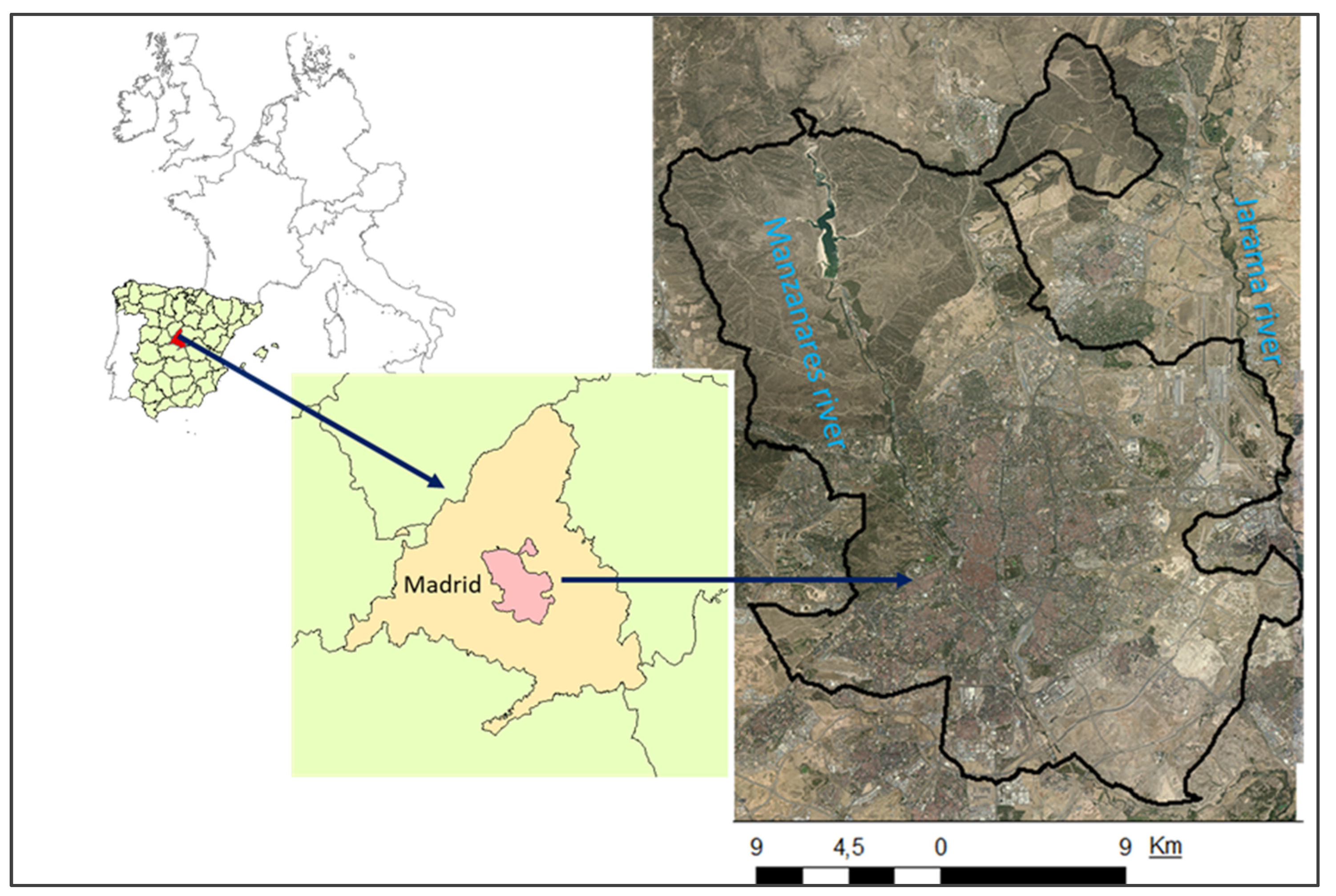
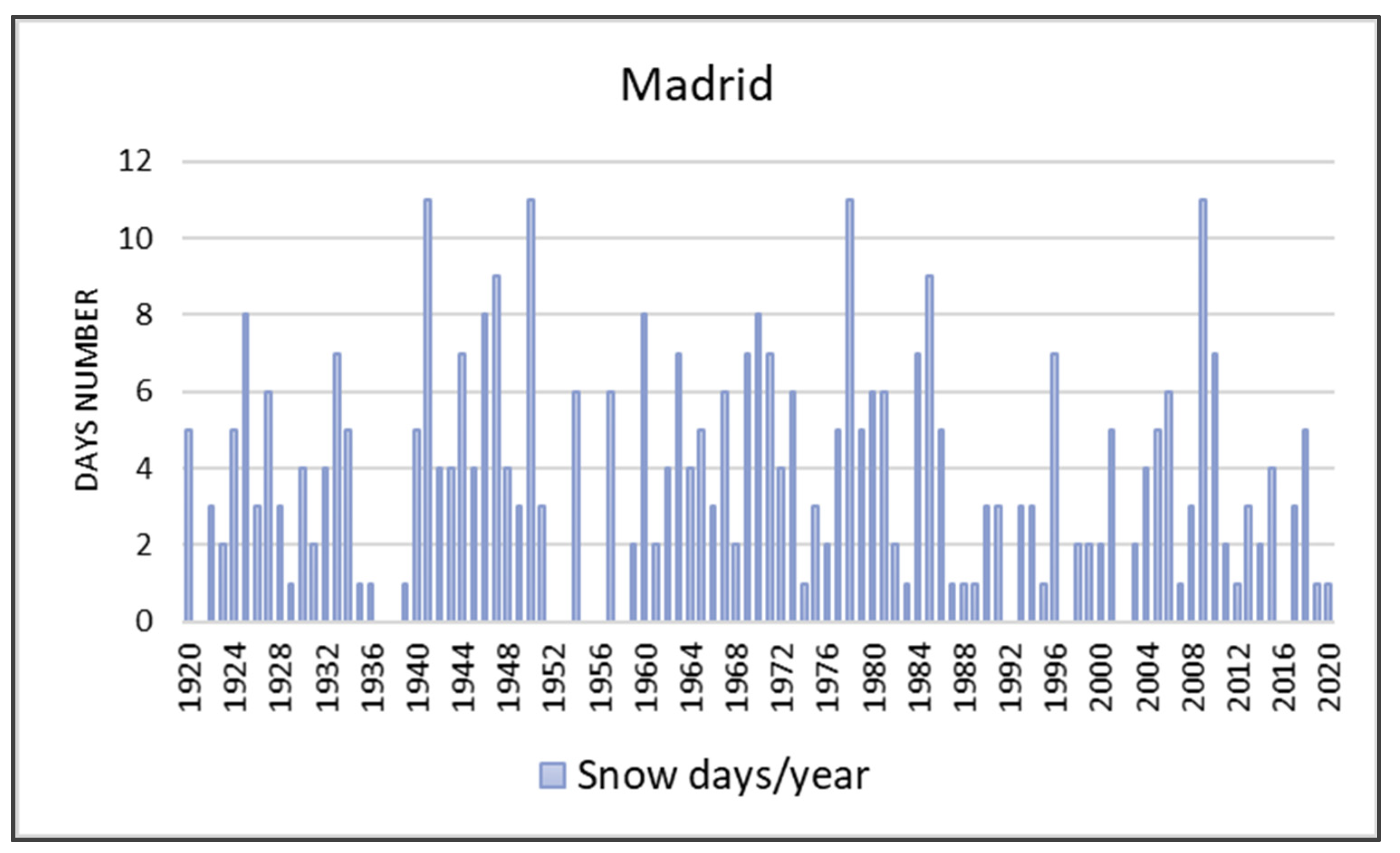
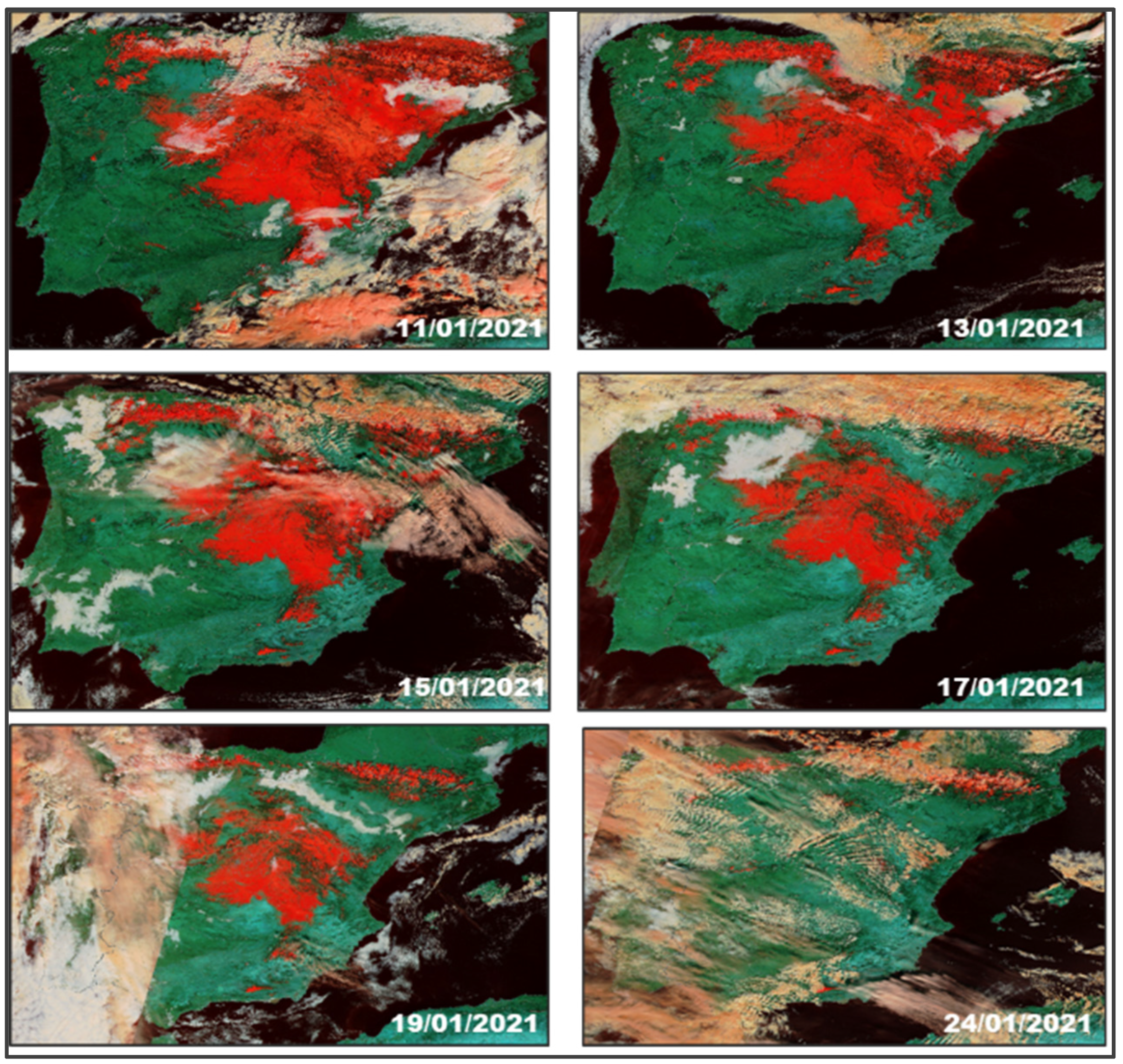
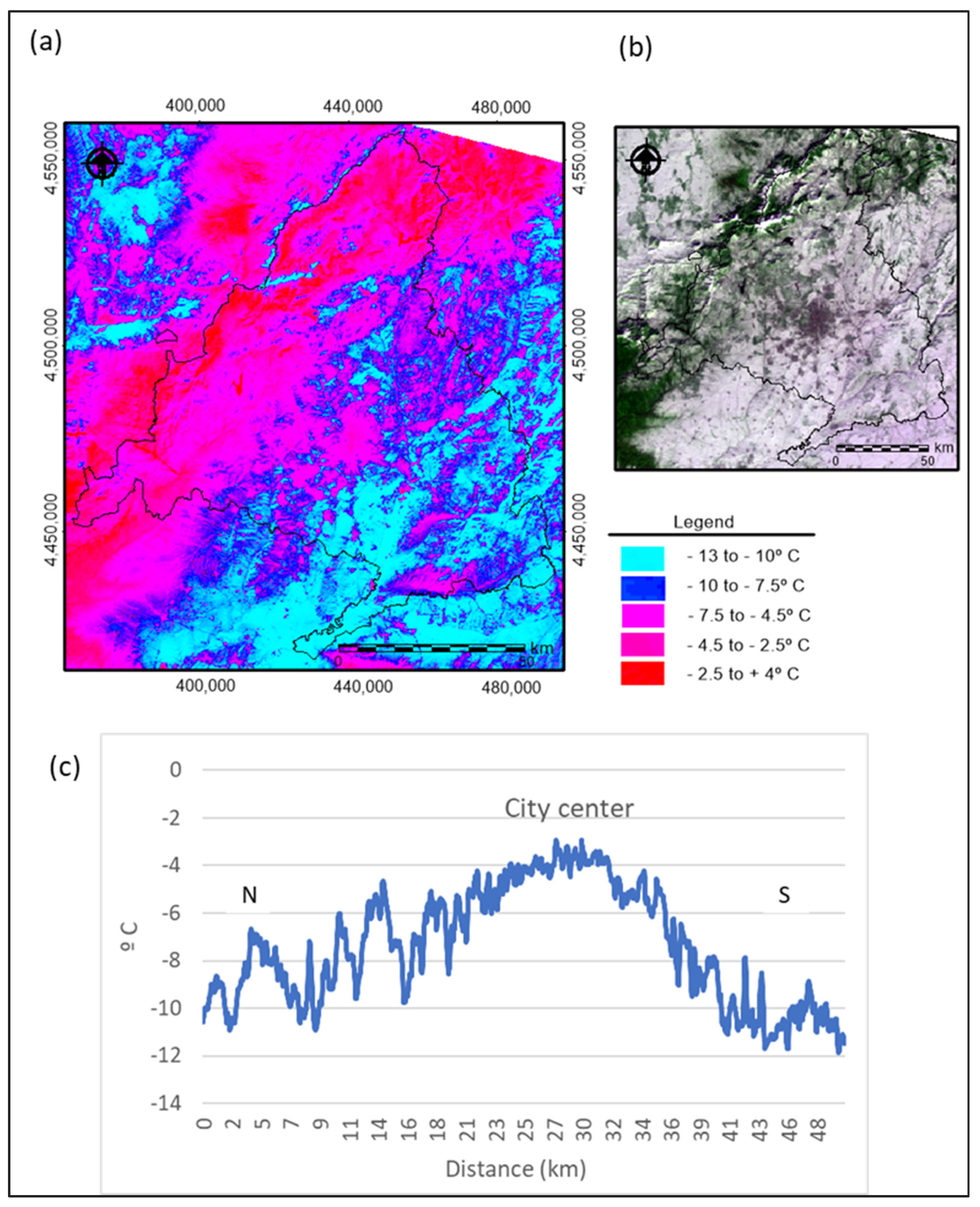
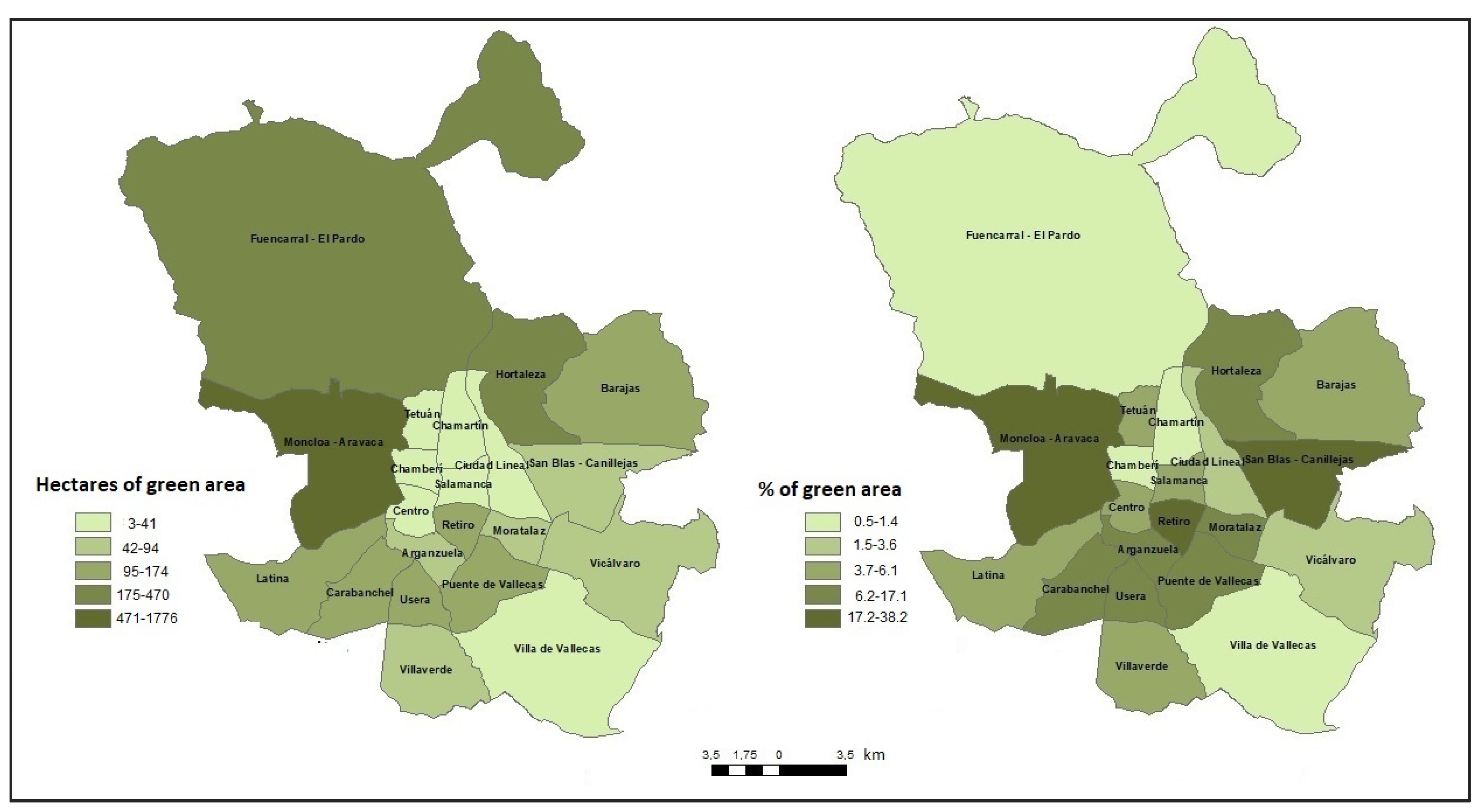
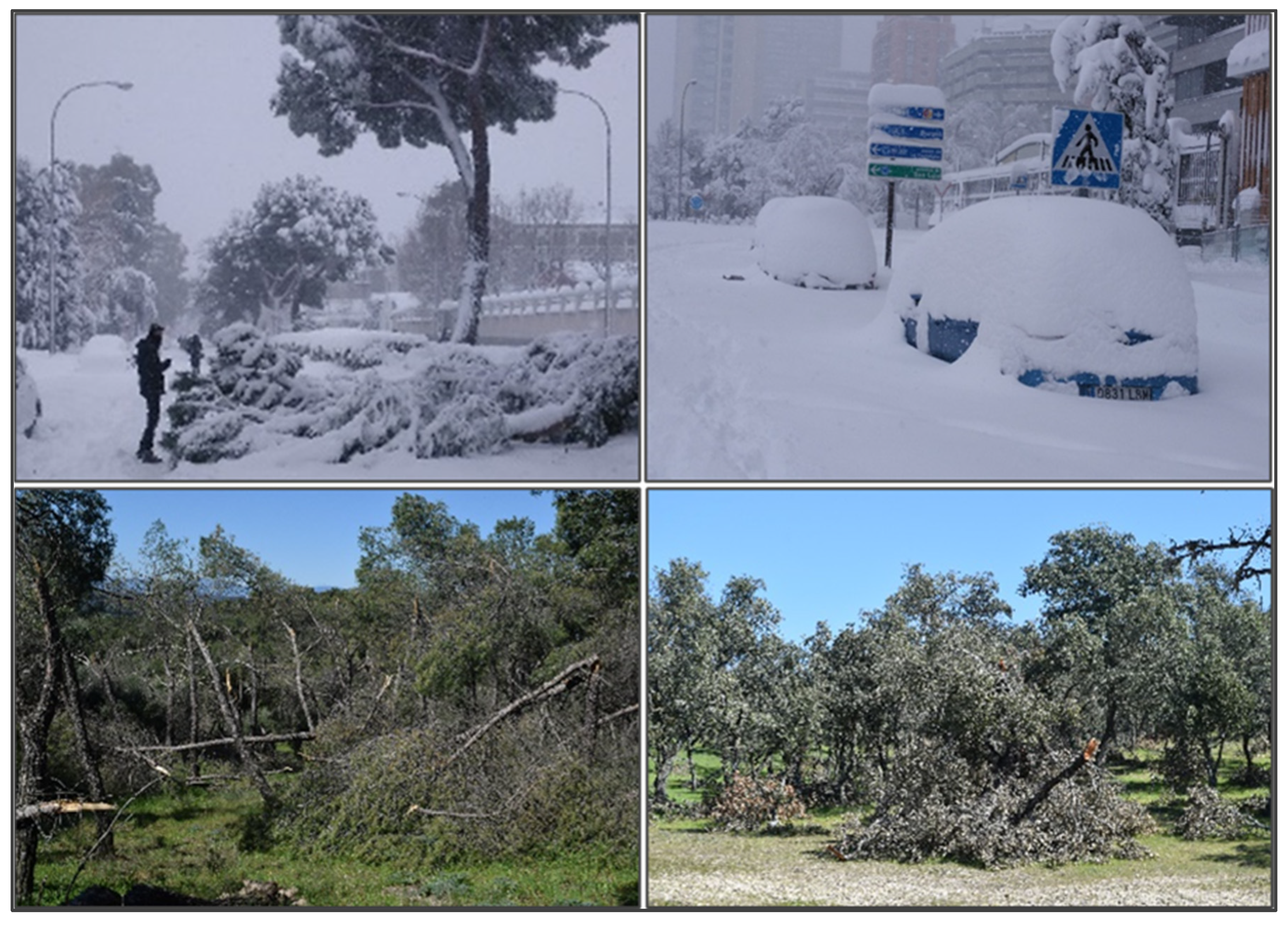
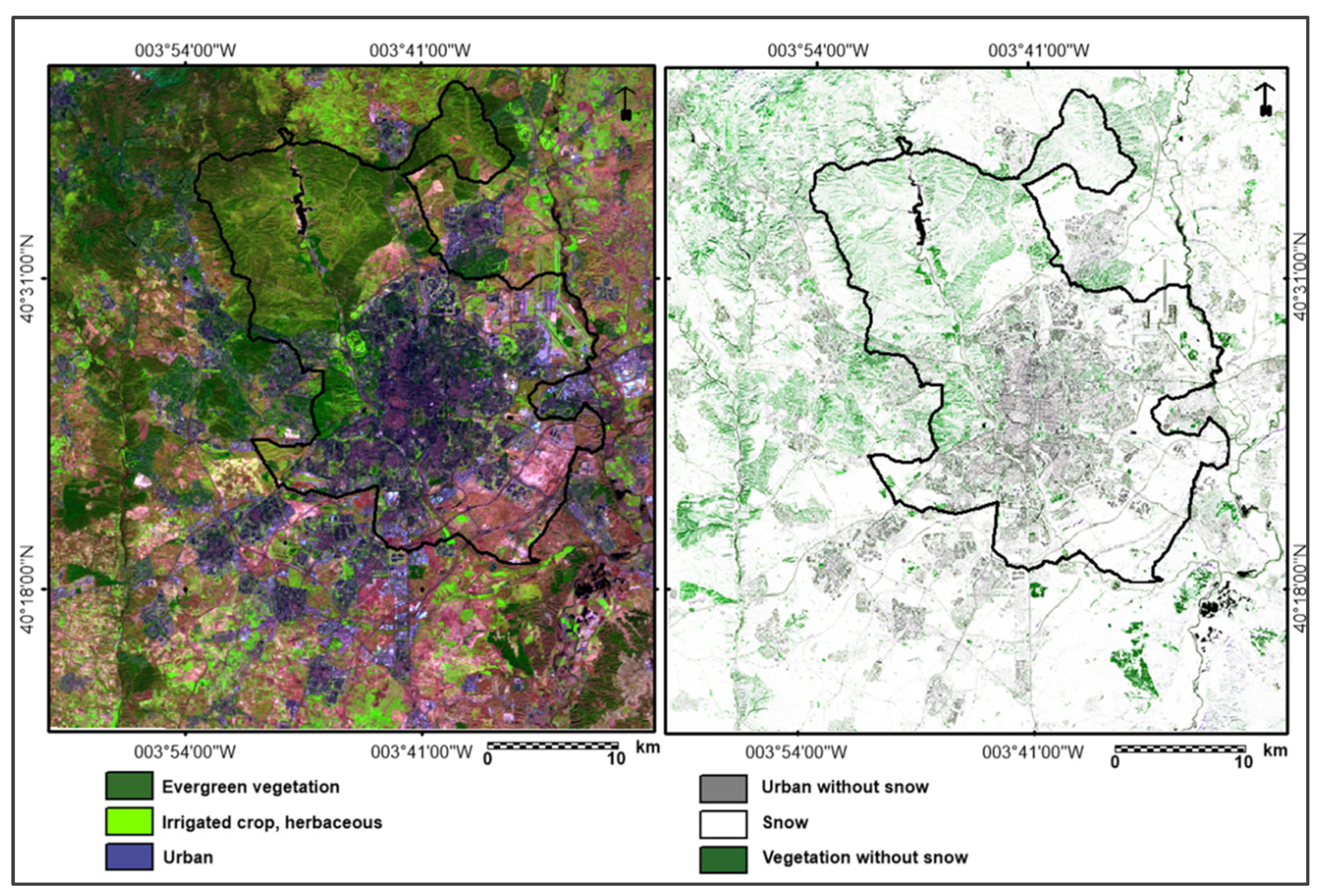
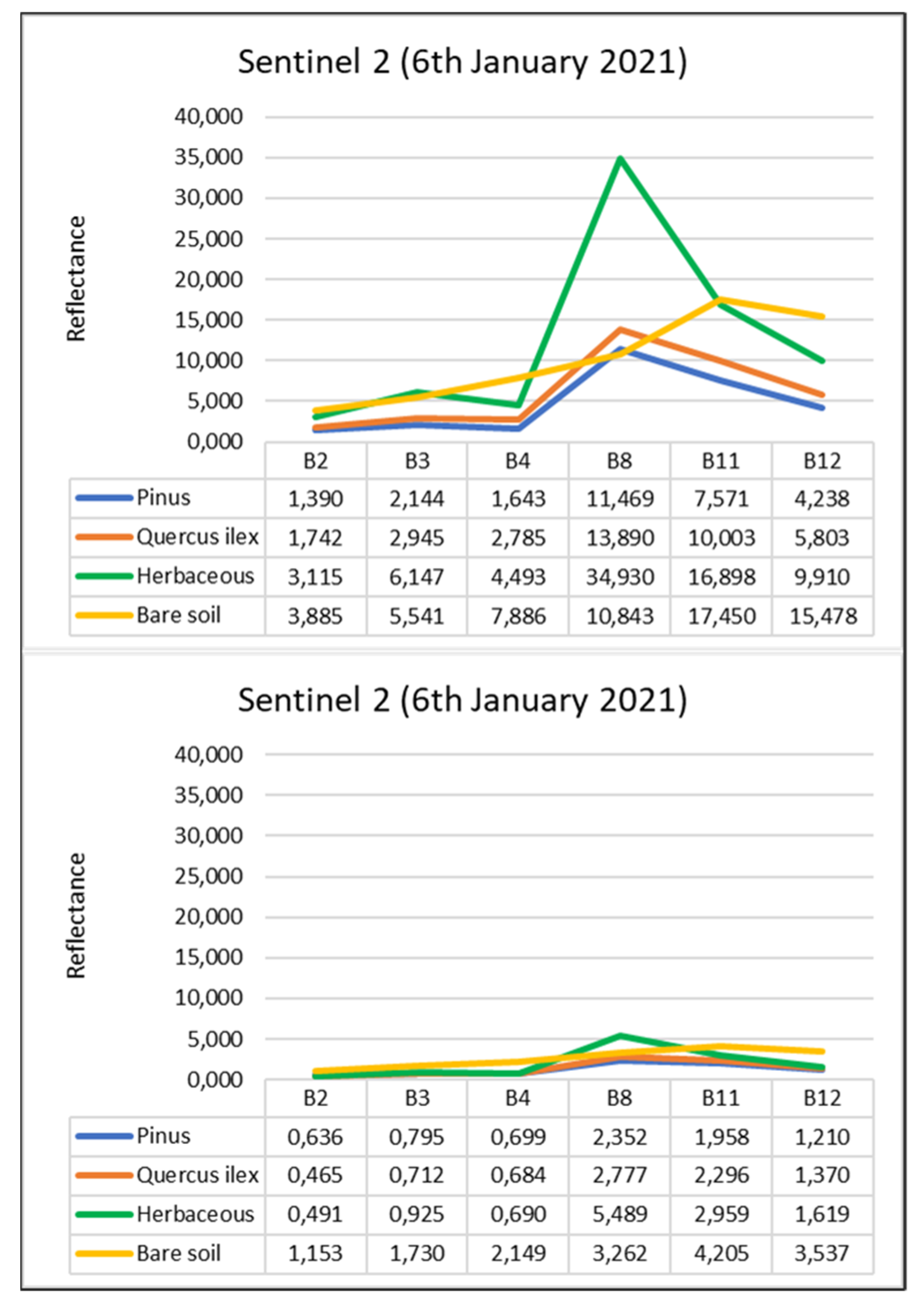
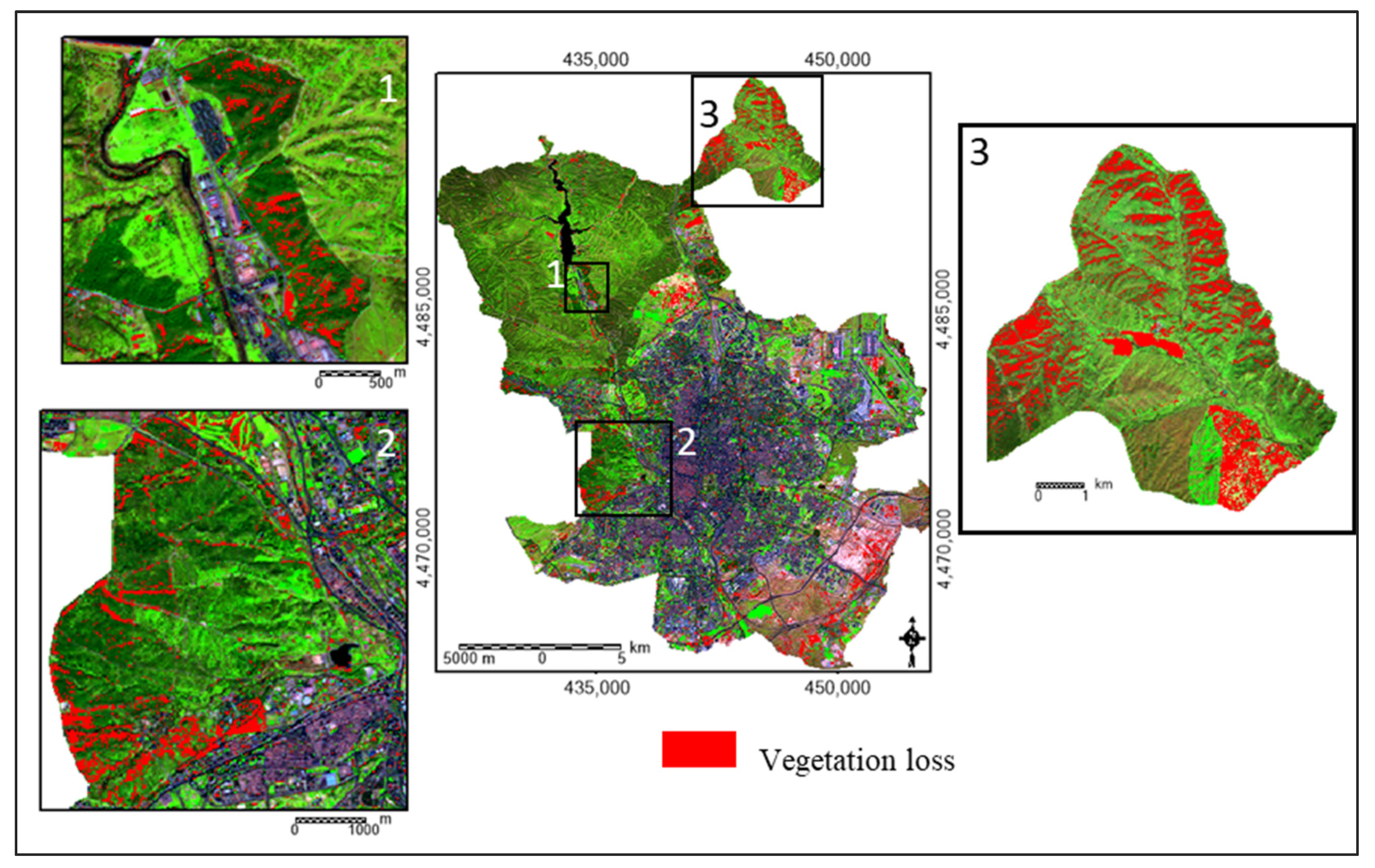
| Winter | Spring | Autumn | ||||
|---|---|---|---|---|---|---|
| 80.57 | 16.06 | 3.37 | ||||
| December | January | February | March | April | October | November |
| 22.02 | 31.09 | 27.46 | 11.92 | 4.15 | 0.26 | 3.11 |
Publisher’s Note: MDPI stays neutral with regard to jurisdictional claims in published maps and institutional affiliations. |
© 2022 by the authors. Licensee MDPI, Basel, Switzerland. This article is an open access article distributed under the terms and conditions of the Creative Commons Attribution (CC BY) license (https://creativecommons.org/licenses/by/4.0/).
Share and Cite
Pérez-González, M.E.; García-Alvarado, J.M.; García-Rodríguez, M.P.; Jiménez-Ballesta, R. Evaluation of the Impact Caused by the Snowfall after Storm Filomena on the Arboreal Masses of Madrid. Land 2022, 11, 667. https://doi.org/10.3390/land11050667
Pérez-González ME, García-Alvarado JM, García-Rodríguez MP, Jiménez-Ballesta R. Evaluation of the Impact Caused by the Snowfall after Storm Filomena on the Arboreal Masses of Madrid. Land. 2022; 11(5):667. https://doi.org/10.3390/land11050667
Chicago/Turabian StylePérez-González, María Eugenia, José María García-Alvarado, María Pilar García-Rodríguez, and Raimundo Jiménez-Ballesta. 2022. "Evaluation of the Impact Caused by the Snowfall after Storm Filomena on the Arboreal Masses of Madrid" Land 11, no. 5: 667. https://doi.org/10.3390/land11050667
APA StylePérez-González, M. E., García-Alvarado, J. M., García-Rodríguez, M. P., & Jiménez-Ballesta, R. (2022). Evaluation of the Impact Caused by the Snowfall after Storm Filomena on the Arboreal Masses of Madrid. Land, 11(5), 667. https://doi.org/10.3390/land11050667







